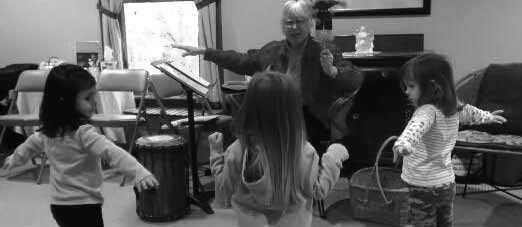 Orff music is a fun way for children to explore music doing what kids love to do. Group classes encourage young children to explore their creativity and musical expression, as they experience music by moving, singing, and playing instruments.
Orff music is a fun way for children to explore music doing what kids love to do. Group classes encourage young children to explore their creativity and musical expression, as they experience music by moving, singing, and playing instruments.
MOVE … SING … DANCE … CLAP … PLAY!
Orff music classes are a fun way for children to explore and create music. They learn to accompany songs and improvise rhythms and melodies using both unpitched and melody instruments.
In the Orff process, children learn through doing, exploring, and improvising.
The emphasis is on experiencing music in ways that are fun and exciting.
Learn More:
The Orff Approach +
Carl Orff (1895-1982) is probably best known as the composer of Carmina Burana. As an educator, he developed a unique approach to creative music teaching, known as Orff Schulwerk, which has inspired a global movement in music education.
There are Orff music chapters for teachers in all 50 states, and in countries all over the world. While the children are actively making music, they are being guided through a step-by-step process that moves them forward through ever increasing skill levels.
Based on solid, pedagogical principles, Orff philosophy applies a structured, sequential development of knowledge and skills to help each child grow musically. However, Orff is more than music alone; it is integral part of Orff classes. Because of the innate connection between rhythm and language, Orff music gives children a head start in their language development and reading skills.
In addition, using local nursery rhymes and folk music, the Orff process is applicable in any culture and language. Thus, music from around the world can be incorporated in Orff music classes.
Orff Instruments +
Orff melody instruments played with mallets are unique to the Orff classes because they are child size, easily accessible, and have a good quality of sound. These instruments include xylophones (bass, alto, soprano,) metallophones (bass, alto, soprano,) and glockenspiels (alto, soprano.) All instruments have removable bars so that “wrong” notes can be removed to make playing and improvising easier.
Unpitched metal instruments (triangles, bells, tambourines, cabasa, cow bells, ingle taps,) wooden instruments (tone blocks, guiro, rhythm sticks, claves,) and numerous shakers and drums are among the many instruments the children can choose to play.
Orff Music Education Benefits +
Orff Music helps children:
Develop Musical Skills, Enhance Coordination, Improve Listening Skills, Increase Language Skills, Expand Creativity, Build Self-Confidence, and Work Cooperatively in Groups.










